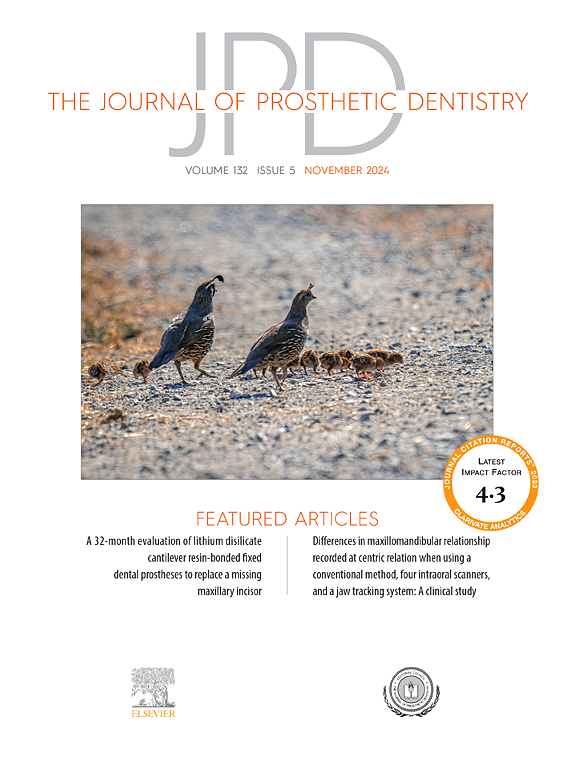先进定制喷射与数字口内扫描制备氧化锆冠边缘与内配合的体外研究。
IF 4.8
2区 医学
Q1 DENTISTRY, ORAL SURGERY & MEDICINE
引用次数: 0
摘要
问题说明:先进定制喷射(ACJ)是一种创新的高精度氧化锆冠三维(3D)打印工艺,数字扫描在牙科领域得到了广泛的应用。然而,不同的记录方法(传统硅胶和数字扫描)对acj制造的氧化锆冠在模拟临床条件下对拔牙固接后的边缘和内部配合的影响尚不清楚。目的:本体外研究的目的是评估和比较在模拟临床条件下,硅胶印模和数字扫描、减法制造(SM)和ACJ对氧化锆冠边缘和内部配合的影响。材料与方法:由口腔修复医师自行制备下颌第一磨牙36颗,随机分为3组。采用三种方法制作冠:硅胶印模联合SM (SS)、数字扫描联合SM (DS)、数字扫描联合ACJ (DA)。修复冠后,将标本置于水浴中浸泡24小时。采用切片技术对每个标本的3个中心切片进行选择和抛光。测量边缘、轴向、角向和咬合配合,并使用方差分析统计检验进行分析(α= 0.05)。结果:三组间的边缘、角度和咬合差异有统计学意义(p结论:ACJ技术比SM技术表现出更好的边缘和内部拟合。DA组一致显示出最低的差异值,强调ACJ和数字扫描在实现高精度氧化锆冠方面的联合潜力。本文章由计算机程序翻译,如有差异,请以英文原文为准。
Marginal and internal fit of zirconia crowns fabricated by advanced custom jetting and digital intraoral scanning: An in vitro study
Statement of problem
Advanced custom jetting (ACJ) is an innovative high-precision 3-dimensional (3D) printing process for zirconia crowns, and digital scanning has gained widespread adoption in dentistry. However, the impact of different recording methods (conventional silicone versus digital scanning) on the marginal and internal fit of ACJ-fabricated zirconia crowns after cementation under simulated clinical conditions on extracted teeth remains unclear.
Purpose
The purpose of this in vitro study was to evaluate and compare the effects of silicone impressions and digital scanning, as well as subtractive manufacturing (SM) and ACJ, on the marginal and internal fit of zirconia crowns under simulated clinical conditions.
Material and methods
Thirty-six mandibular first molars were prepared by a prosthodontist and randomly assigned to 3 groups. The crowns were fabricated using 3 methods: silicone impression combined with SM (SS), digital scanning combined with SM (DS), and digital scanning combined with ACJ (DA). After cementing the crowns, the specimens were placed in a water bath for 24 hours. A sectioning technique was used to select and polish the 3 central sections of each specimen. Marginal, axial, angular, and occlusal fits were measured and analyzed using the MANOVA statistical test (α=.05).
Results
Statistically significant differences in marginal, angular, and occlusal discrepancies were observed among the 3 groups (P<.001). The DA group exhibited the lowest marginal (47.5 ±17.2 µm), angular (68.8 ±23.2 µm), and occlusal (87.7 ±40.1 µm) discrepancies, while the SS group displayed the highest values (79.9 ±31.2 µm, 144.4 ±56.9 µm, and 206.7 ±63.7 µm, respectively). For axial discrepancies, the DA group showed significantly lower values (52.9 ±16.8 µm) compared with the SS group and DS group (P<.001). These findings indicate that the DA group achieved better marginal and internal fit than the SS group and the DS group.
Conclusions
ACJ demonstrated better marginal and internal fit than SM techniques. The DA group consistently exhibited the lowest discrepancy values, underscoring the combined potential of ACJ and digital scanning in achieving high precision zirconia crowns.
求助全文
通过发布文献求助,成功后即可免费获取论文全文。
去求助
来源期刊

Journal of Prosthetic Dentistry
医学-牙科与口腔外科
CiteScore
7.00
自引率
13.00%
发文量
599
审稿时长
69 days
期刊介绍:
The Journal of Prosthetic Dentistry is the leading professional journal devoted exclusively to prosthetic and restorative dentistry. The Journal is the official publication for 24 leading U.S. international prosthodontic organizations. The monthly publication features timely, original peer-reviewed articles on the newest techniques, dental materials, and research findings. The Journal serves prosthodontists and dentists in advanced practice, and features color photos that illustrate many step-by-step procedures. The Journal of Prosthetic Dentistry is included in Index Medicus and CINAHL.
 求助内容:
求助内容: 应助结果提醒方式:
应助结果提醒方式:


